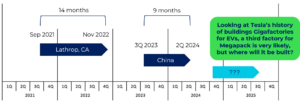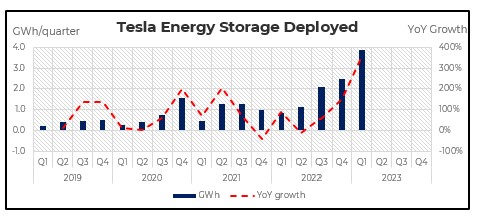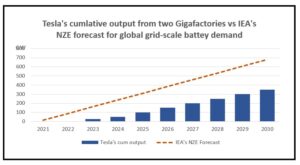Tesla Energy … Massive Growth in Megapack Manufacturing
Posted by | Michael Ratcliffe
Tesla has announced plans for a second Gigafactory focused solely on the production of Megapack energy storage systems, positioning it ready to dominate this key sector of the green sustainable energy market. Located in Shanghai, when combined with the Megapack Gigafactory Tesla opened in California in late 2022, this will make it one of, if not the largest, global manufacturers of grid-scale storage systems by the end of 2024.
Second Tesla Megapack Gigafactory
In April 2023, Tesla announced plans to build a second Gigafactory for grid-scale Megapack battery systems in China. Tesla will partner with leading Chinese battery manufacturer CATL, who specialize in the technology used in Megapacks, Lithium Iron Phosphate batteries, and who they are already working with in Lathrop, CA.
What is really impressive about this announcement is that Tesla is planning to start from a greenfield site, complete this massive Chinese factory and begin production of Megapacks in just 9 months! Tesla’s first Megapack Gigafactory in Lathrop, CA was built in just over a year, so to cut construction time to just 9 months is amazing when you consider the size of this factory and that other companies can take two years to build an equivalent factory.
With an ability to complete a new Gigafactory in under a year, Tesla has to be seen as a major competitive threat to any other player in grid-level storage and even local mini-grid markets. As and when Tesla might see demand for grid storage starting to ramp up somewhere in the world, it has the potential to build a new factory in months not years, minimizing its risk and being the first to capture the emerging demand.
This leaves the key competitive question on the table – “Where will Tesla build its third Gigafactory dedicated to Megapacks?”
 Timeline of Construction of Tesla’s EV Gigafactories
Timeline of Construction of Tesla’s EV Gigafactories
Tesla Energy already has lift-off
Tesla’s Q1 2023 filing reported that its electricity storage systems grew by a very impressive 360% compared to Q1 2022, to nearly 4 GWh!
The Tesla Gigafactory in Lathrop, CA was only opened in Q4 2022 and recent reports are that it is already producing 10 to 12 Megapacks a day. With each unit having a potential output of 3.9 MWh, we only have to do the math to see that Lathrop is producing a total of 3.9 GWh a quarter! And that’s only 40% of the plant’s annual capacity of 40 GWh per year or around 10,000 Megapack units a year. It is also reported that Tesla has a 2 year wait list, implying it already has the demand to ramp up production significantly beyond 40%.
 Tesla Energy Storage Deployed
Tesla Energy Storage Deployed
If we look at storage capacity rather than power output, at 10,000 units Lathrop could be supplying up to 25 GW of grid-level storage a year. If we combine this with the potential output with Tesla’s new China plant, by 2025 the combined output could be as high as 50 GW per year. To put this into perspective, these two factories on their own could satisfy 50% of the IEA’s latest global forecast for installed grid-scale battery storage in 2030 of 680 GW.
 Cumulative output from two Tesla Gigafactories vs IEA’s NZE Forecast for Global Grid-Scale Battery Demand
Cumulative output from two Tesla Gigafactories vs IEA’s NZE Forecast for Global Grid-Scale Battery Demand
Another way of looking at Tesla’s storage production capacity is against the plans of the three major European oil companies, BP, Shell and TotalEnergies, all of whom have ambitious plans to get into renewables. Their total combined storage plans for 2030 are around 25 GW, or equivalent to the output of one Tesla Megapack Gigafactory in just one year!
Tesla’s Competitive Strategy
If Tesla keeps to its plan to build this factory by mid 2024, it will be another example of the company being a true disrupter.
Following the launch of the Megapack in 2019, Tesla has taken center stage and potentially assumed the dominant position in the global grid-level storage market. It has entered as a low-cost alternative to expensive and polluting natural gas peaker plants and is now rapidly expanding into other segments of the electricity storage market. Today, just 4 years later, it has to be seen as THE potential future supplier of green grid storage facilities around the world.
If you are involved in the renewable energy market, you need to make sure you understand the potential implications of Tesla Energy’s strategy and the implications for your business. For instance, if you are in, or planning to invest in, the battery or power management market, whether at the grid-level, micro-grid level or domestic resident level, you need to recognize that you are very likely facing a very serious competitive threat. If you are in some other sector of the green energy market, you need to think through the potential knock-on effect on your market of Tesla Energy dominating the storage sector in the near-term.
And if you think grid-level storage is the end of Tesla’s energy strategy, we suggest you think twice. With that power in the grid market, you can bet your bottom dollar Elon Musk is going to do something with it. One thing for certain is “trade” … watch for our third article on Tesla Energy. Also keep in mind that Tesla Energy is already selling electricity generation systems with its solar roof systems. To date it has sold around 0.5 million to the domestic US market. A logical expansion would be for it to also move into the commercial solar market and become a truly integrated renewables player, and that has the potential to disrupt the entire green energy market.
Further Reading
> Tesla Energy: The Green Energy Storage Giga-Disrupter
Tags: Disruption, Energy, Innovation, Tesla



















